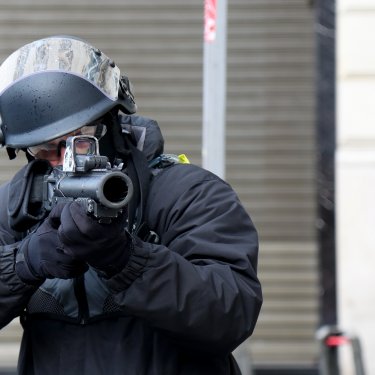Police violence against reporters during “yellow vest” protests in Paris

Reporters Without Borders (RSF) calls on the French ombudsman to investigate the many reports of serious targeted police violence against journalists, especially photographers, while they were covering the “gilets jaunes” (yellow vest) protests held last Saturday (8 December) to call for President Macron’s resignation.
Some journalists reported being the targets of stingball grenades and flash-ball rounds fired at close range. The police also confiscated protective equipment, including helmets, goggles and gas-masks, and other professional equipment from journalists, although they were clearly identified as such.
In some cases, reporters were threatened with arrest if they did not surrender their equipment.
“We urge the authorities to shed light on this violence, to return the professional equipment, including protective equipment, that was confiscated from journalists, and to guarantee that there will be no further confiscations in the future,” RSF secretary-general Christophe Deloire said. “In view of the gravity of these events, we also call on the ombudsman, Jacques Toubon, to examine the various acts of violence.”
The newspaper Parisien-Aujourd’hui en France reported that two of its photographers were hit by flash-ball rounds on the Champs-Elysées. One of them, Yann Foreix, reported on Twitter then he lost consciousness after being hit in the back of the neck and was rushed to hospital. Paul Conge, a reporter for the news website Explicite, was hit by a stingball grenade in the mid-thigh.
Other reporters and press photographers described scenes of exceptional violence and said they were deliberately targeted. Although wearing a press armband, JDD photographer Éric Dessons’s hand was broken when he was hit twice by a member of the CRS riot police during a clash between police and protesters on the Champs-Elysées.
Thomas Morel-Fort, a photographer whose left hand sustained multiple fractures when hit by flash-ball rounds, said: “My helmet was clearly marked with the word press, and my photographer’s ID card was visible.”
“This is the first time we have seen so many cases of violence, and with such serious consequences,” said Wilfrid Estève of Studio Hans Lucas, for which several dozen photographers work. “All of these experienced professionals were clearly identified by press badges and yet many of them were targeted from behind, in the back.”
Several photographers working for the newspaper Libération described similar cases in the newspaper’s reports. One was hit in the face. Another had to lie down to protect himself. Others said flash-ball rounds were aimed at them.
Some journalists complained that had been exposed to more danger by the confiscation of their helmets and other protective equipment.
“They made us more vulnerable and even put us in danger,” said Véronique de Viguerie, a recipient of this year’s Visa d’Or award, referring to the confiscation of a bag containing two masks and two helmets for her and a fellow freelance photographer.
Studio Hans Lucas photographer Julien Autier was threatened with arrest if he did not surrender his gas mask. Boris Allin, a photographer who freelances for Libération, reported on Twitter that the police officers who confiscated his equipment were not displaying any identification numbers.
Under the French constitution, the ombudsman is an independent authority tasked with defending rights and freedoms. His duties include ensuring that the police respect their professional code of conduct.
Last year, RSF asked Ombudsman Jacques Toubon to investigate ten cases of journalists who were subjected to unwarranted police violence during demonstrations. In a report to the National Assembly on 10 January 2018, Toubon recommended a ban on the use of flash-ball rounds during law enforcement operations.
France is ranked 33rd out of 180 countries in RSF’s 2018 World Press Freedom Index.



